Pay Bills
- Select a company and check payment batch.
- To create a new batch, select Create New Batch on the batch drop down menu.
- There are three ways to add invoices to bill paying batches.
- After setting the parameters, click Add To Batch. The invoices that match your criteria are added to the batch and displayed on the screen. Invoices that have already been paid or are in another batch will not be included in a new batch.
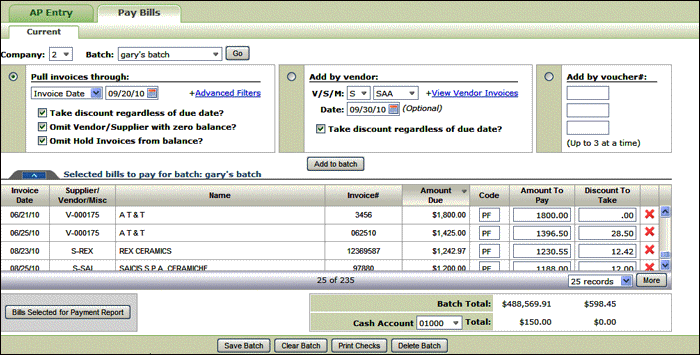
- The transaction Code tells the program how to process the item. For example, code PF means payment in full. The codes you will use most often are:
- PF - full payment.
- PP - partial payment.
- CF - selects a vendor's credit memo or any item that appears in the Debit column to be applied against bills.
- CP - partial credit
- If a discount is available, it automatically shows up in the Discount to Take field.
- The amount paid to a vendor or supplier is always equal to the Amount to Pay minus the Discount. For example, if you enter a PF code against a $100.00 vendor invoice and $2.00 in the To Disc field, $98.00 is paid on the check. The check lists the amount paid and the discount taken for each invoice.
- Select a Cash Account from which to fund the checks. The invoices are tied to cash accounts when they are entered in AP Entry.
- Click Print Checks.
- The number of vendors and/or suppliers.
- The type/format of check being printed. Some laser printed checks require more space.
- Vendor/Supplier File - Policy Code 1C directs the system to issue a separate check for every invoice. The default is to pay multiple invoices with one check.
- The printer assigned in the field Print Checks on the User Web Control Panel (NAV 5).
- If an actual printer is assigned, the checks are sent to that printer and are generÂated as a PDF file under the ODS heading in the upper right-hand corner.
- If a phantom printer is assigned (the printer does not exist), the checks are generated as a PDF file under the ODS heading. The PDF can then be printed using preprinted forms.
- Take discount regardless of due date - This option takes all available discounts on the selected bills without checking to see if the due date has passed.
- Omit vendor/supplier w/ neg or zero balance? - The Pull Invoices Through program is hard-coded to not pull any vouchers for a Vendor/Supplier that has an overall negative balance. If this setting is unchecked, the system will pull in at least the positive vouchers of a zero or negative balance vendor/supplier.
- Omit Hold Invoices from balance - This field directs the system to check if there are invoices in the date range specified that are marked as hold and omit them from the balance calculation to pay.
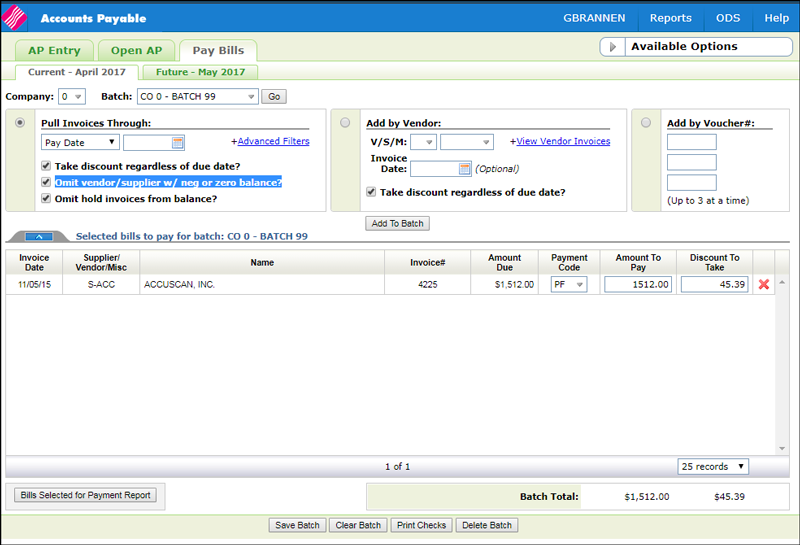
Use the Print Listings of Bills Selected for Payment button to verify your selections and the amount required to pay the selected bills or items. The PDF report that is produced shows the number of checks required for each account. Review the PDF file and make any necessary changes, additions, or deletions by going back resetting the parameters in the Pull invoices through, Add by vendor, or Add by voucher# options.
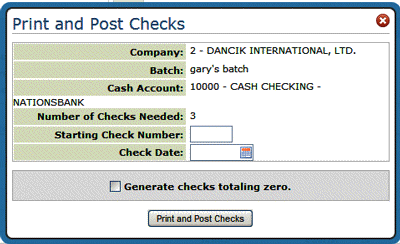
There are several settings that dictate how many checks are needed. Among them are:
The Starting Check Number can be the same number for multiple accounts. In some cases, the Starting Check Number might already be entered and cannot be changed. This functionality is controlled a check number wheel accessed through the A/P & G/L Defaults Maintenance File (menu option ACT 109). This function is recommended for users that prefer to have the system display the next check number or users that have dedicated printers (or printer drawers) for checks, and do not need to perform a printer line-up each time checks are printed. This function eliminates having to manually enter the starting check number for each Accounts Payable check.
The setting Generate checks totaling zero lets you decide about printing checks that equal zero. If activated, checks with zero balances are generated and issued a check number. If not activated (the default), the calculation and printing of zero checks is skipped.
Where the checks are printed depends on the following settings:
After the checks are printed, the invoices are removed from the batch. However, the batch name is not deleted and can be reused. To remove a batch name, use the Delete Batch button.
Pull Invoices Through
Use this option to ask the system to select bills by Invoice, Pay, or Voucher date. These dates are on a company-wide basis and encompass all vendors and suppliers. Only invoices with dates on or before the date entered are pulled.
The following options are available:
The Advanced Filters allow to limit the invoices pulled to specific branches and/or Supplier Groups. Supplier Groups provide another level of organization of payments. For example, you can group vendors by the type of product or service they provide, and generate checks by group. You can set up groups for installers, import suppliers, domestic suppliers, etc.
Add by Vendor
To add all the invoices from a vendor or supplier, simply enter the vendor/supplier code and click Add to Batch. Use the optional date feature to view invoices for the vendor from this invoice date and forward.
To select items to be paid on an invoice-by-invoice basis, click the View Vendor Invoices link.
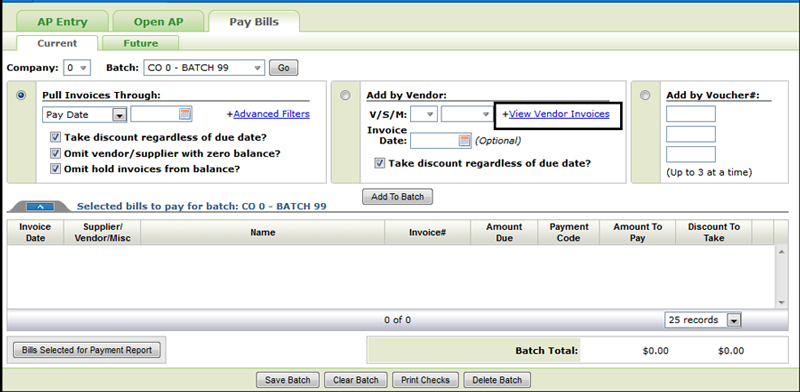
When the View Invoices by Vendor link is click, the following window appears.
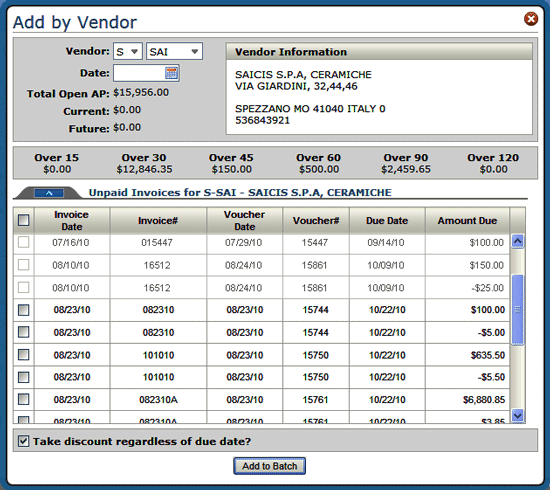
Invoices that are grayed out have already been added to a batch.
Add by Voucher#
Use this option to add three vouchers at a time to a batch. The vouchers can be from any supplier or vendor. Even held vouchers can be selected for payment.
Associated Files for Check Writing
Company File (Menu option FIL 5) - The Check Voucher Format field.
Web Control Panel (Menu NAV 5 - OPTION Y) - Page 3 contains settings for check formats.
Vendor/Supplier Files - Hold/Force number- Sometimes you will want to pay certain vendors a little later or earlier than others based upon your knowledge of your vendor's expectations or systems. The use of this field lets the system know which vendors should be paid earlier or later. A positive number in this field tells the system to hold, or pay later, by the number of weeks you specify. A negative number tells the system to force, or pay early, by the number of weeks you specify. For example, an entry of 03 will have the following effect: If you automatically pay all vendor bills through May 31st, this particular vendor's bills will be paid only through May 10th. His bills are held three weeks longer. An entry of 03- (negative three weeks) causes this vendor's bills through June 21 to be paid. His bills are forced into being paid three weeks early. By assigning Hold/Force#'s to all vendors to whom this applies, you can create a flexible and automatic payment schedule which incorporates separate payment schedules for each vendor or supplier.
